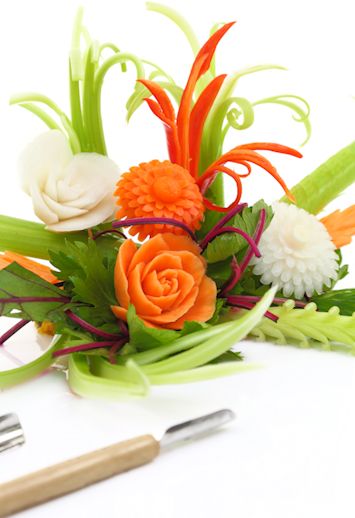Preparing and shaping vegetables
The most tedious task when preparing a dish is without a doubt peeling and chopping the vegetables. So it comes as no surprise to see that mechanical devices for vegetables (and fruit) began to be developed in the late 19th century. Vegetables are churned out in particular shapes depending on how they are used in a recipe. All of this preparation is part of getting everything ready to make a recipe. In Asian cuisine, vegetables are carved into genuine works of art and decorate both dishes and tables.
The tedious task of preparing vegetables
Getting the ingredients ready and preparing them is a major task when making a dish from a recipe.
Mechanisation has sought to streamline some operations for preparing vegetables, such as pealing and chopping for example. In the late 19th century, small mechanical devices were designed for peeling and chopping potatoes and vegetables. Many of these devices still exist, although nowadays they are manufactured from new materials. However, a number of these inventions were not successful, such as the hand-cranked potato and carrot peeler. Once cut, vegetables are used either as a garnish or as ingredients in the preparation of stocks, soups, sauces and other recipes.
Sharp utensils for beautiful carving
The simplest pieces of equipment for cutting vegetables are the knife and chopping board. It is much easier to chop with well-sharpened knives. Blunt knives actually crush the vegetable cells unnecessarily and promote oxidation. Mandolins are more sophisticated than knives. Nowadays such cutting devices are used by both professionals and individuals. A mandolin is composed of a sharp blade attached at an angle to a support across which raw vegetables are slid and thus sliced. In the past, mandolins were made from wood, but nowadays they are made from stainless steel or plastic.
Vegetables of different shapes, sizes and names
Diced into two, five or eight millimetre cubes, in the culinary world, such vegetables are called Brunoise, Jardiniere and Macedoine respectively and are used either as a garnish or as ingredients. Mirepoix vegetables are diced and used to flavour brown stock. Cutting is therefore less precise and the size is determined by the cooking time. Thinly sliced, they are called paysanne vegetables for a garnish or matignon vegetables if they are to be ingredients for stock or soups.
Once washed and peeled, potatoes can be diced, cut into sticks, sliced into rounds, scooped into balls and even turned. Cut into sticks, they are called straws, matchsticks, chips or Pommes Pont-Neuf (thickly cut French fries). In rounds, they are used, for example, to make gratins. Pommes parisiennes are shaped into small, round balls. They are scooped out of potatoes with a half spherical spoon. A turned potato is carved with a knife and traditionally has seven sides. Depending on its length, it is called a cocotte, château, vapeur or fondante potato.
A paring knife is used not just for peeling, but also for making ‘spaghetti’ with carrots, courgettes or other vegetables.
Vegetables can also be carved into truly ephemeral works of art for decorating dishes and tables. In Asian countries, vegetable carving is an ancestral art which originated in China between the 10th and 13th centuries CE. Carvings were then created for the Emperor and his Court. During the 20th century, this art became increasingly popular for fruit as well, cut to resemble leaves, flowers or geometric shapes.
Nutrition
In preparing vegetables, the smaller the pieces they are cut into, the greater the risk of losing vitamins.
SCHÄRER, Martin R et RABOUD-SCHÜLE, Isabelle, 1995. Histoires d’objets. Vevey : Nestec S.A.
PAULI, Philip, 2008. Technologie culinaire. Winterthur : Pauli Fachbuchverlag AG
CISELET, Bénédicte et Philippe, s.d. Sculpture sur fruits et légumes. Saveur thaïlandaise [en ligne]. [Consulté le 01.02.2016]. Disponible à l’adresse : http://www.saveurs-thailandaises.com







